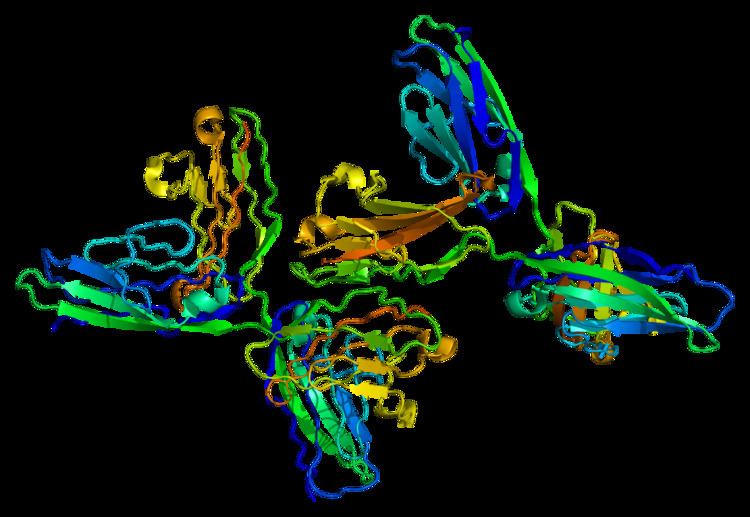Entrez 4684 | Ensembl ENSG00000149294 | |
 | ||
External IDs OMIM: 116930 MGI: 97281 HomoloGene: 40754 GeneCards: NCAM1 | ||
Neural cell adhesion molecule (NCAM), also called CD56, is a homophilic binding glycoprotein expressed on the surface of neurons, glia, skeletal muscle and natural killer cells. NCAM has been implicated as having a role in cell–cell adhesion, neurite outgrowth, synaptic plasticity, and learning and memory.
Contents
Forms, domains and homophilic binding
NCAM is a glycoprotein of Immunoglobulin (Ig) superfamily. At least 27 alternatively spliced NCAM mRNAs are produced, giving a wide diversity of NCAM isoforms. The three main isoforms of NCAM vary only in their cytoplasmic domain:
The extracellular domain of NCAM consists of five immunoglobulin-like (Ig) domains followed by two fibronectin type III (FNIII) domains. The different domains of NCAM have been shown to have different roles, with the Ig domains being involved in homophilic binding to NCAM, and the FNIII domains being involved signaling leading to neurite outgrowth.
Homophilic binding occurs between NCAM molecules on opposing surfaces (trans-) and NCAM molecules on the same surface (cis-)1. There is much controversy as to how exactly NCAM homophilic binding is arranged both in trans- and cis-. Current models suggest trans- homophilic binding occurs between two NCAM molecules binding antiparallel between all five Ig domains or just IgI and IgII. cis- homophilic binding is thought to occur by interactions between both IgI and IgII, and IgI and IgIII, forming a higher order NCAM multimer. Both cis- and trans- NCAM homophilic binding have been shown to be important in NCAM “activation” leading to neurite outgrowth.
Minor exons
Another layer of complexity is created by the insertion of other "minor" exons in the NCAM transcript. The two most notable are:
Posttranslational modification
NCAM exhibits glycoforms as it can be posttranslationally modified by the addition of polysialic acid (PSA) to the fifth Ig domain, which is thought to abrogate its homophilic binding properties and can lead to reduced cell adhesion important in cell migration and invasion. PSA has been shown to be critical in learning and memory. Removal of PSA from NCAM by the enzyme endoneuraminidase (EndoN) has been shown to abolish long-term potentiation (LTP) and long-term depression (LTD).
Expression in normal cells
The neural cell adhesion molecule NCAM1 appears on early embryonic cells and is important in the formation of cell collectives and their boundaries at sites of morphogenesis.
Later in development, NCAM1 (CD56) expression is found on various differentiated tissues and is a major CAM mediating adhesion among neurons and between neurons and muscle.
Function
NCAM is thought to signal to induce neurite outgrowth via the fibroblast growth factor receptor (FGFR) and act upon the p59Fyn signaling pathway.
In nerves, NCMA1 regulates homophilic (like-like) interactions between neurons and between neurons and muscle; it associates with fibroblast growth factor receptor (FGFR) and stimulates tyrosine kinase activity of receptor to induce neurite outgrowth. When neural crest cells stop making N-CAM and N-cadherin, and start displaying integrin receptors, cells separate and migrate.
During hematopoiesis, CD56 is the prototypic marker of NK cells, also present on subset of CD4+ T cells and CD8+ T cells.
In cell adhesion, CD56 contributes to cell-cell adhesion or cell-matrix adhesion during embryonic development.
Pathology
In anatomic pathology, pathologists make use of CD56 immunohistochemistry to recognize certain tumors.
Alzheimers
NCAM2 is found in lower levels in synapses in the hippocampuses of Alzheimers sufferers and is found to be broken down by beta-amyloid
Anti-NCAM therapy
NCAM has been used as a target molecule for experimental antibody-based immunotherapy. Successful radioimmunolocalisation of metastases was demonstrated after giving injections of NCAM-binding 123J-UJ13a or 131J-UJ13a radioimmunoconjugates to children with neuroblastoma. Patients with small cell lung cancer were treated with the anti-NCAM immunotoxine huN901-DM1 in two different clinical studies, revealing acceptable toxicity and signs of clinical response.
